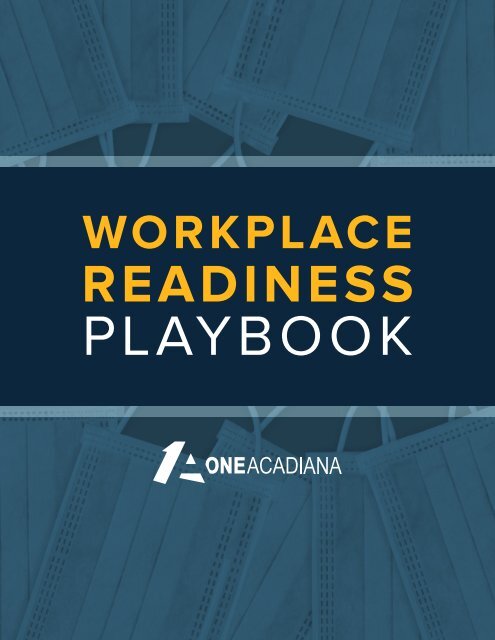Workplace Readiness Playbook
You also want an ePaper? Increase the reach of your titles
YUMPU automatically turns print PDFs into web optimized ePapers that Google loves.
WORKPLACE<br />
READINESS<br />
PLAYBOOK
A HOW-TO GUIDE FOR<br />
REOPENING YOUR WORKPLACE<br />
As areas stabilize from the COVID-19 pandemic and stay-at-home<br />
restrictions are lifted, organizations will begin to bring workers back<br />
into the physical workplace.<br />
One Acadiana’s “<strong>Workplace</strong> <strong>Readiness</strong> <strong>Playbook</strong>” outlines some of<br />
the best thinking and practices on how businesses can safely return<br />
to the workplace following the COVID-19 outbreak.<br />
We are proud to release this comprehensive guide and look forward<br />
to connecting with you to learn more about how we can help.
PREPARE THE BUILDING<br />
Evaluating the space, cleaning plans, pre-return inspections,<br />
HVAC and mechanical checks<br />
• Conduct a thorough evaluation of your work environment<br />
ɣɣ<br />
ɣɣ<br />
ɣɣ<br />
Use a floorplan of your office space or conduct a walk through to note the number of<br />
workstations and seating capacity for each space, include lobbies, conference rooms,<br />
and other meeting spaces.<br />
Note areas in the workplace with surfaces that provide high introduction or transmission<br />
opportunities like office supply storage, photocopiers, break areas, restrooms, and<br />
high-traffic areas where employees or customers may cross paths en route to other<br />
areas of the office.<br />
For high-traffic areas, establish a traffic pattern plan to circulate movement in only one<br />
direction within your workplace. Communicate the traffic pattern to guests and employees.<br />
Use signage or tape on the floor to remind employees and guests of traffic patterns.<br />
• Deep clean and disinfect your workplace<br />
ɣɣ<br />
ɣɣ<br />
ɣɣ<br />
ɣɣ<br />
Consider engaging a professional deep<br />
cleaning/restoration service to prepare<br />
the building for reopening.<br />
Ensure your workplace cleaning company<br />
is up to date on current methods of safely<br />
removing COVID-19 hazards.<br />
Clean and disinfect all surfaces in your<br />
workspace – workstations, counters,<br />
photocopiers, common areas, door<br />
handles, electronics,<br />
soft surfaces, etc.<br />
CDC Guidance on Facility Cleaning Prior<br />
to Reopening can be found HERE.<br />
1
• Ready Mechanical, HVAC,<br />
Fire/Life Safety systems<br />
ɣɣ<br />
Replace air filters after flushing<br />
the building/increasing fresh air<br />
intake. Refer to manufacturers’<br />
recommendations and guidance<br />
for filter selection Use the highest<br />
efficiency rated filter recommended/<br />
allowed by the manufacturer<br />
(MERV rating) and reference WHO<br />
guidelines HERE.<br />
• Place hand sanitizer stations at key entry points.<br />
• Post the Families First Coronavirus Response Act (FFCRA) poster in a visibale place.<br />
Send via email to employees who remain working from home.<br />
• Post reminders of social distancing, hygiene, and cleaning protocols.<br />
• Ensure compliance with owner/Landlord requirements policies.<br />
• Engage vendors in back-to-work plan.<br />
• Review and prepare plans regarding changes to cleaning scope or any<br />
additional services.<br />
• Ensure all inspections, remediations, repairs, new construction, furniture additions/<br />
removal, communications, and final deep cleaning are complete before reopening.<br />
2
REVIEW & REVISE POLICIES<br />
Update policy and procedure manuals, reinforce and clarify new procedures<br />
• Designate a workplace coordinator who will<br />
be responsible for COVID-19 issues and their<br />
impact at the workplace.<br />
• Review and revise hiring<br />
practices and policies<br />
ɣɣ<br />
ɣɣ<br />
ɣɣ<br />
ɣɣ<br />
ɣɣ<br />
Have staffing needs changed?<br />
Do you need to change<br />
benefits or pay to become<br />
more competitive?<br />
Use remote interviewing techniques as much<br />
as possible.<br />
Update onboarding practices.<br />
If you are recalling only some workers that<br />
were laid-off or furloughed, ensure your<br />
practices for determining who to recall do not<br />
discriminate against any group of employees.<br />
• Review and revise leave policies<br />
ɣɣ<br />
ɣɣ<br />
ɣɣ<br />
ɣɣ<br />
Know how the FFCRA affects your previous policies and practices.<br />
Consider implementing PTO/vacation rollovers, grace periods, and revise guidelines for<br />
usage if vacation is forfeited if not used by year end.<br />
Consider implementing or revising bereavement<br />
leave policies.<br />
Ensure that all employees have access to and an understanding of all leave policies that<br />
may apply to them.<br />
3
• Review and revise work-from-home and childcare policies.<br />
• Update work travel policies in light of any new state or federal orders and any new<br />
practices being implemented in the workplace to keep employees/customers safe.<br />
• Review rehire/reinstate provisions for your benefit policies (eligibility/waiting periods).<br />
• Be prepared to quickly investigate and stop discriminatory speech or acts in<br />
the workplace.<br />
• Train managers on dealing with employees that may face increased personal<br />
challenges during this time, such as bereavement and loss, childcare and<br />
school-cancellation challenges, financial stress, and other dependent care<br />
and support needs.<br />
• Offer flexibility wherever possible and adjust workloads to be reasonable.<br />
• Distribute all new or revised policies to all employees<br />
4
PREPARE THE WORKFORCE<br />
Policies for deciding who returns and when; employee communications<br />
• Mitigate anxiety of returning to the workplace through change management<br />
planning and communications.<br />
• Consider why people can benefit from returning to work<br />
ɣɣ<br />
Productivity from proximity to colleagues; socialization; amenities; and work tools &<br />
resources<br />
• Consider why people can benefit from working from home<br />
ɣɣ<br />
Health and family priorities; reduced commute time; technology enables WFH without<br />
loss of productivity<br />
5
• Develop and execute detailed plan on how to return to work<br />
ɣɣ<br />
Explain company policies and procedures related to illness, cleaning and disinfecting, and<br />
work meetings and travel.<br />
ɣɣ<br />
Educate employees on how to reduce the spread of COVID-19 at home and at work –<br />
follow CDC recommendations HERE.<br />
ɣɣ<br />
ɣɣ<br />
ɣɣ<br />
ɣɣ<br />
ɣɣ<br />
ɣɣ<br />
Ensure employees understand what’s expected of them in the workplace. For example,<br />
must they wear face masks or face coverings? Will protective items and hand sanitizer be<br />
provided? Are workplace hours different? Will you be taking employees’ temperatures<br />
each day when they arrive? Is teleworking or staggered shift work allowed/encouraged?<br />
Ensure that all employees who are currently ill or have contact with an ill family member<br />
stay home – follow CDC recommendations HERE.<br />
If an employee becomes sick at work, send them home.<br />
Promote safe social distancing in the workplace by encouraging employees to:<br />
--<br />
Remain at least 6 feet away from each other<br />
--<br />
Email, message, call, or video call rather than meeting face to face.<br />
--<br />
Clean computer equipment, desktops, phones, and workstations often.<br />
Provide hand sanitizer, cleaning supplies, and face masks or face coverings (where<br />
appropriate/necessary) and no-touch disposal receptacles.<br />
Discourage handshaking.<br />
• Prepare and post reminders of social<br />
distancing, hygiene, and cleaning protocols.<br />
• Communicate your appreciation and<br />
welcome employees back to work.<br />
6
CONTROL ACCESS<br />
Protocols for safety and health checks, building reception, shipping/receiving,<br />
• Control the entry points including deliveries<br />
ɣɣ<br />
Consider locking doors, posting signs to arrange for entry, or scheduling deliveries<br />
• Reconfigure conference rooms and lobby areas for social distancing<br />
• Install plexiglass shields as appropriate<br />
• Clearly communicate building protocols through signage and floor markings<br />
• Consider temperature screening for any individual entering the building<br />
• Provide sanitizer, wipes, PPE as appropriate<br />
• Disable touchscreens<br />
7
SOCIAL DISTANCING PLAN<br />
Decreasing density, schedule management, office traffic patterns<br />
• Consider phasing based on roles<br />
and priorities.<br />
ɣɣ<br />
ɣɣ<br />
ɣɣ<br />
Alternating work weeks in the office and<br />
working from home<br />
Staggered arrival/departure times<br />
Enable teams to negotiate their own<br />
‘in-office’ schedules<br />
• Introduce planning to support social<br />
distancing/6 feet office protocols.<br />
• Monitor space usage.<br />
• Specify seating assignments for<br />
employees to ensure staff adheres to<br />
minimum work distances.<br />
• Redesign spaces, alternate desk/chair use, etc., for social distancing.<br />
• Enforce stringent cleaning protocols for shared spaces.<br />
• Reduce capacity of space – e.g., remove some chairs from large conference rooms.<br />
• Prohibit shared use of small rooms<br />
and convert them to single-occupant<br />
use only.<br />
• Designate and signpost the direction of foot-traffic in main circulation paths.<br />
8
REDUCE TOUCH POINTS<br />
& INCREASE CLEANING<br />
Touchless entry, clean desk policy, food plan, cleaning common areas<br />
• Maintain enhanced cleaning and<br />
disinfecting practices.<br />
• Supply disinfectants near or on each desk or<br />
work area, particularly those that are shared.<br />
• Remove communal food and ‘buffet-style’ meals<br />
– consider restocking with single-serving items.<br />
• Disable communal beverage stations –<br />
e.g., coffee pots, water coolers.<br />
• Enable DIY cleaning through hand sanitizer, disinfectant wipes, and other<br />
such products.<br />
• Sanitize all workspace areas, including office, conference room, breakroom, cafeteria,<br />
restroom, and other areas prior to opening. Ensure appliances/equipment are in<br />
working order.<br />
• Limit in-person meetings.<br />
• Consider low-touch or no-touch switches, doors, drawers and other fittings.<br />
• Remove high-touch shared tools such as whiteboard markers, remote controls, etc.<br />
• Institute a clean desk policy.<br />
• Create secured, designated storage areas for personal items – e.g., lunch boxes,<br />
umbrellas, coats, jackets, etc.<br />
9
COMMUNICATE FOR CONFIDENCE<br />
Recognize the fear in returning, communicate transparently,<br />
listen/survey regularly<br />
• Ensure leadership alignment on reentry<br />
• Establish two-way communication<br />
• Ensure a trusting and transparent culture<br />
• Connection to a vision: As changes in protocol and policies are unveiled, find ways to<br />
connect those messages back to the corporate vision. Understanding the “why” is a<br />
great way to reinforce the “what.”<br />
• Clearly set employee expectations, with an emphasis on making them feel secure<br />
ɣɣ<br />
ɣɣ<br />
ɣɣ<br />
ɣɣ<br />
Return to work/work-from-home policies and incentives<br />
Guest and visitor policies<br />
Employee travel policies<br />
HR policies regarding illness, support for caregivers, etc.<br />
10
BEST PRACTICES FOR<br />
INDIVIDUALS & EMPLOYERS<br />
GUIDELINES FOR ALL PHASES: INDIVIDUALS<br />
Continue to adhere to State and local guidance as well as complementary<br />
CDC guidance, particularly with respect to face coverings.<br />
CONTINUE TO PRACTICE GOOD HYGIENE<br />
Wash your hands with soap and water or use hand sanitizer, especially<br />
after touching frequently used items or surfaces.<br />
Avoid touching your face.<br />
Sneeze or cough into a tissue, or the inside of your elbow.<br />
Disinfect frequently used items and surfaces as much as possible.<br />
Strongly consider using face coverings while in public, and particularly<br />
when using mass transit.<br />
PEOPLE WHO FEEL SICK SHOULD STAY HOME<br />
Do not go to work or school.<br />
Contact and follow the advice of your medical provider.<br />
11
GUIDELINES FOR ALL PHASES: EMPLOYERS<br />
Develop and implement appropriate policies, in accordance with<br />
Federal, State, and local regulations and guidance, and informed by<br />
industry best practices, regarding:<br />
Social distancing and protective equipment<br />
Temperature checks<br />
Sanitation<br />
Use and disinfection of common and high-traffic areas<br />
Business travel<br />
Monitor workforce for indicative symptoms. Do not allow symptomatic<br />
people to physically return to work until cleared by a medical provider.<br />
Develop and implement policies and procedures for workforce contact<br />
tracing following employee COVID+ test.<br />
12
Source Material:<br />
Centers for Disease Control and Prevention<br />
U.S. Chamber of Commerce<br />
WhiteHouse.gov<br />
This material is offered for general information only.<br />
It does not provide, nor is it intended to provide, legal advice.<br />
May 2020

















